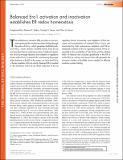| dc.contributor.author | Kim, Sunghwan | |
| dc.contributor.author | Sideris, Polixeni Dionisia | |
| dc.contributor.author | Sevier, Carolyn S. | |
| dc.contributor.author | Kaiser, Chris | |
| dc.date.accessioned | 2012-05-04T20:57:47Z | |
| dc.date.available | 2012-05-04T20:57:47Z | |
| dc.date.issued | 2012-03 | |
| dc.date.submitted | 2011-10 | |
| dc.identifier.issn | 0021-9525 | |
| dc.identifier.issn | 1540-8140 | |
| dc.identifier.uri | http://hdl.handle.net/1721.1/70516 | |
| dc.description.abstract | The endoplasmic reticulum (ER) provides an environment optimized for oxidative protein folding through the action of Ero1p, which generates disulfide bonds, and Pdi1p, which receives disulfide bonds from Ero1p and transfers them to substrate proteins. Feedback regulation of Ero1p through reduction and oxidation of regulatory bonds within Ero1p is essential for maintaining the proper redox balance in the ER. In this paper, we show that Pdi1p is the key regulator of Ero1p activity. Reduced Pdi1p resulted in the activation of Ero1p by direct reduction of Ero1p regulatory bonds. Conversely, upon depletion of thiol substrates and accumulation of oxidized Pdi1p, Ero1p was inactivated by both autonomous oxidation and Pdi1p-mediated oxidation of Ero1p regulatory bonds. Pdi1p responded to the availability of free thiols and the relative levels of reduced and oxidized glutathione in the ER to control Ero1p activity and ensure that cells generate the minimum number of disulfide bonds needed for efficient oxidative protein folding. | en_US |
| dc.description.sponsorship | National Institutes of Health (U.S.) (GM46941) | en_US |
| dc.language.iso | en_US | |
| dc.publisher | Rockefeller University Press, The | en_US |
| dc.relation.isversionof | http://dx.doi.org/10.1083/jcb.201110090 | en_US |
| dc.rights | Creative Commons Attribution-Noncommercial-Share Alike 3.0 Unported | en_US |
| dc.rights.uri | http://creativecommons.org/licenses/by-nc-sa/3.0/ | en_US |
| dc.source | Rockefeller UP | en_US |
| dc.title | Balanced Ero1 activation and inactivation establishes ER redox homeostasis | en_US |
| dc.type | Article | en_US |
| dc.identifier.citation | Kim, S. et al. “Balanced Ero1 Activation and Inactivation Establishes ER Redox Homeostasis.” The Journal of Cell Biology 196.6 (2012): 713–725. Web. 4 May 2012. | en_US |
| dc.contributor.department | Massachusetts Institute of Technology. Department of Biology | en_US |
| dc.contributor.approver | Sunghwan, Kim | |
| dc.contributor.mitauthor | Kim, Sunghwan | |
| dc.contributor.mitauthor | Sideris, Polixeni Dionisia | |
| dc.contributor.mitauthor | Sevier, Carolyn S. | |
| dc.contributor.mitauthor | Kaiser, Chris | |
| dc.relation.journal | Journal of Cell Biology | en_US |
| dc.eprint.version | Final published version | en_US |
| dc.type.uri | http://purl.org/eprint/type/JournalArticle | en_US |
| eprint.status | http://purl.org/eprint/status/PeerReviewed | en_US |
| dspace.orderedauthors | Kim, S.; Sideris, D. P.; Sevier, C. S.; Kaiser, C. A. | en |
| dc.identifier.orcid | https://orcid.org/0000-0002-1505-0479 | |
| mit.license | PUBLISHER_CC | en_US |
| mit.metadata.status | Complete | |
